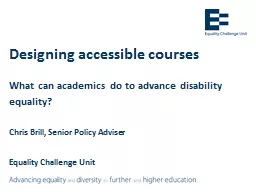

What can academics do to advance disability equality Chris Brill Senior Policy Adviser Equality Challenge Unit Aims and objectives Understand how course arrangements can potentially disadvantage disabled learners and why competence standards are so important ID: 478543
Download Presentation The PPT/PDF document "Designing accessible courses" is the property of its rightful owner. Permission is granted to download and print the materials on this web site for personal, non-commercial use only, and to display it on your personal computer provided you do not modify the materials and that you retain all copyright notices contained in the materials. By downloading content from our website, you accept the terms of this agreement.
Slide1
Designing accessible courses
What can academics do to advance disability equality?
Chris Brill, Senior Policy Adviser
Equality Challenge UnitSlide2
Aims and objectives
Understand….
… how course arrangements can potentially disadvantage disabled learners and why competence standards are so important
Practice….
… developing competence standards that are compliant with disability legislation
Consider…
… how competence standards interact with assessmentSlide3
Firstly, some quick stats….
Question:
What percentage of students disclosed as disabled in 2003/04?Slide4
Firstly, some quick stats….
Answer:
5.4%
Source:
http://www.ecu.ac.uk/guidance-resources/using-data-and-evidence/statistics-report
/
Slide5
Firstly, some quick stats….
Question:
What percentage of students disclosed as disabled in 2013/14?Slide6
Firstly, some quick stats….
Answer:
10.0%
Source:
http://www.ecu.ac.uk/guidance-resources/using-data-and-evidence/statistics-report
/
Slide7Slide8
How can course arrangements potentially
disadvantage disabled
learners? Slide9
What are the barriers?Slide10
Some solutionsSlide11
What are the barriers?Slide12
Definition
‘
An
academic, medical or other standard
applied for the purposes of determining whether or not a person has a
particular level of competence or ability
.’
Equality Act 2010 (
Sch
13, para 4(3
))
‘The requirement for students studying for a
law degree
to demonstrate a
particular standard of knowledge of certain areas of law
in order to obtain the degree is a competence standard.’
(EHRC, 2010
)Slide13
Recap of the key points so far…
Adjustments
can be made to physical environment, equipment and aids, and policies and practices
Different universities may use
different terms
for competence standards
Competence
standards
are applied to determine
whether or not a person
has a particular level of competence or ability
.
Universities have a legal responsibility to ensure competence standards are
non-discriminatorySlide14
Developing
non-discriminatory competence standardsSlide15
Developing non-discriminatory competence standards
1)
Is the standard under development or review
a competence standard
or is it some
other kind of criterion or policy
? Slide16
Yes or No?
A modern language course
has a
requirement that students spend a year abroad.
Is the year
abroad
a
competence
standard? Slide17
Answer
The
year abroad itself
is not on its own
a competence
standard.
The
competence standards will be the
knowledge
and
skills
which the student will be expected to acquire during the year abroad.
This
requirement would therefore be subject to the duty to make
reasonable adjustments.Slide18
Developing non-discriminatory competence standards
2)
Is
the competence standard an
appropriate
and
necessary
way of meeting a
legitimate aim
?Slide19
Developing non-discriminatory competence standards
Is
the
aim
or
intention legitimate
in the
context
of the course?
Is the competence standard
genuinely relevant
to the course?
Is the competence standard an
appropriate
and
necessary
means of achieving the
aim
?
Could the competence standard have an
adverse impact
on a disabled student?Slide20
Yes or No?
Is
requiring students to gain skills in listening and speaking in a different
language a
competence
standard?
YES
NO
Modern Language
Comparative LiteratureSlide21
Developing non-discriminatory competence standards
3) Is
this competence standard
articulated
in a way which may present unnecessary barriers to disabled students? Slide22
Yes or No?
Are any of these skills essential for your courses?
YES
NO
Speaking
Listening
Handwriting
CommunicationSlide23
Recap: key questions when developing competence standards
Is
the standard under development or review
a competence standard
or is it some
other kind of criterion or policy
?
Is the competence standard an
appropriate
and
necessary
way of meeting a
legitimate aim
?
Is
this competence standard
articulated
in a way which may present unnecessary barriers to disabled students?Slide24
Key points: assessing competence standards
Adjustments can be made to the way competence standards are assessed
Providing
a range of modes of
assessments
Provide clear instruction
Develop a team approachSlide25
Take home 3 points…
Competence standards have different associated
legal requirements
than other standards
Competence standards should be a
proportionate means of achieving a legitimate aim
Reasonable adjustments
can be made
to the way that competence standards are
assessedSlide26
Resources
ECU work on competence standards
http://www.ecu.ac.uk/guidance-resources/student-recruitment-retention-attainment/student-retention/inclusive-learning-teaching/competence-standards-reasonable-adjustments/
Disability
legislation
: practical
guidance for academic
staff Revised 2010 (ECU and HEA guidance)
http://
www.ecu.ac.uk/wp-content/uploads/external/disability-legislation-for-academics-revised.pdf
Slide27
Any questions…
Chris Brill, Equality Challenge Unit
0207 438 1021
Chris.brill@ecu.ac.uk